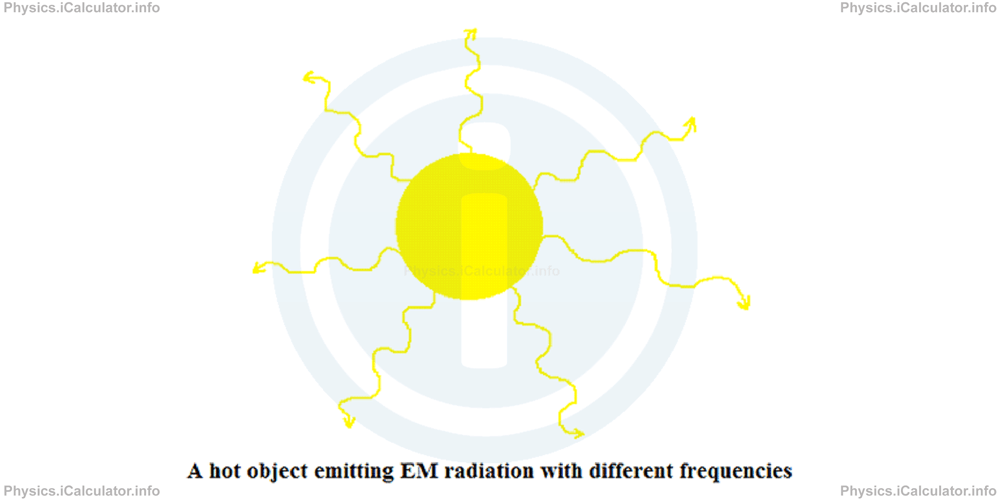Menu
Physics Lesson 11.6.1 - What Are Electromagnetic Waves?
Please provide a rating, it takes seconds and helps us to keep this resource free for all to use
Welcome to our Physics lesson on What Are Electromagnetic Waves?, this is the first lesson of our suite of physics lessons covering the topic of Electromagnetic Waves. Light, you can find links to the other lessons within this tutorial and access additional physics learning resources below this lesson.
What Are Electromagnetic Waves?
Electromagnetic (in short EM) waves are transverse waves emitted by hot objects when they release some of their energy to the surroundings during the cooling process. These waves have different frequencies, depending on their temperature. We will see in Section 13 that internal energy of objects is proportional to their temperature.

The entirety of EM waves produced by a hot source is otherwise known as Electromagnetic Radiation. Sun is our main source of EM radiation. Since the Sun is about 150 million kilometres away from the Earth, most of the path followed by EM waves that fall on the Earth consists on vacuum. Therefore, EM waves propagate differently from mechanical ones, i.e. unlike mechanical waves, EM waves do not need a material medium to propagate as discussed in our Physics tutorial on "Types of Waves and the Simplified Equation of Waves"
EM waves propagate at a very high speed. In vacuum the speed of EM waves reach a value of 300 000 km/s. This is the highest known speed in the universe. Since the speed of EM waves is much greater than the other known speeds, we use the letter 'c' instead of 'v' to represent it in formulae. Thus, the equation of waves for EM radiation becomes
where λ is the wavelength and f is the frequency of EM waves.
We often refer to the speed of EM radiation as the "speed of light", although the visible light is only a small portion of EM radiation produced by the Sun. Therefore, we are unable to see all phenomena occurring around us because of our limited ability to detect all kinds of EM waves.
Example 1
A yellow light ray has a wavelength of 600 nm. What is its frequency in Hz? (1 nm = 10-9 m).
Solution 1
First, we must write the speed of EM waves (speed of light) in standard form. Thus, we have
= 300 000 000 m/s
= 3 × 108 m/s
Also, we have for the wavelength of the yellow light ray:
= 600 × 10-9 m
= 6 × 10-7 m
Applying the equation of waves for the EM radiation
we obtain for the frequency of the given yellow light ray
= (3 × 108 m/s)/(6 × 10-7 m)
= 0.5 × 108 - (-7) Hz
= 0.5 × 1015 Hz
= 5 × 1014 Hz
As you see, this is a very big value. This is the reason why we are not able to detect the oscillations of the light rays but we see them only as straight lines.
You have reached the end of Physics lesson 11.6.1 What Are Electromagnetic Waves?. There are 2 lessons in this physics tutorial covering Electromagnetic Waves. Light, you can access all the lessons from this tutorial below.
More Electromagnetic Waves. Light Lessons and Learning Resources
Whats next?
Enjoy the "What Are Electromagnetic Waves?" physics lesson? People who liked the "Electromagnetic Waves. Light lesson found the following resources useful:
- Definition Feedback. Helps other - Leave a rating for this definition (see below)
- Waves Physics tutorial: Electromagnetic Waves. Light. Read the Electromagnetic Waves. Light physics tutorial and build your physics knowledge of Waves
- Waves Revision Notes: Electromagnetic Waves. Light. Print the notes so you can revise the key points covered in the physics tutorial for Electromagnetic Waves. Light
- Waves Practice Questions: Electromagnetic Waves. Light. Test and improve your knowledge of Electromagnetic Waves. Light with example questins and answers
- Check your calculations for Waves questions with our excellent Waves calculators which contain full equations and calculations clearly displayed line by line. See the Waves Calculators by iCalculator™ below.
- Continuing learning waves - read our next physics tutorial: Diffraction of Waves
Help others Learning Physics just like you
Please provide a rating, it takes seconds and helps us to keep this resource free for all to use
We hope you found this Physics lesson "Electromagnetic Waves. Light" useful. If you did it would be great if you could spare the time to rate this physics lesson (simply click on the number of stars that match your assessment of this physics learning aide) and/or share on social media, this helps us identify popular tutorials and calculators and expand our free learning resources to support our users around the world have free access to expand their knowledge of physics and other disciplines.